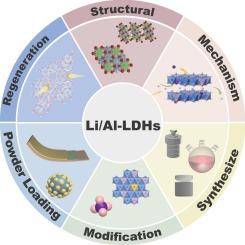The recent advances and modification strategies of Li/Al-LDHs toward lithium extraction
IF 9.8
1区 工程技术
Q1 ENGINEERING, CHEMICAL
引用次数: 0
Abstract
The soaring demand for lithium resources has driven increasing interest in extracting lithium from low-grade brines. Among available techniques, adsorption is considered the optimal method due to its efficiency and selectivity. Lithium‑aluminum layered double hydroxide (LiAl-LDHs) has emerged as the only commercially implemented adsorbent, owing to its high adsorption efficiency, excellent structural stability, and mild desorption conditions. Nevertheless, its inherently limited adsorption capacity remains a major constraint. Although extensive research has been devoted to modifying Li/Al-LDHs materials in recent years, a comprehensive and systematic review remains scarce. This study systematically investigates the correlation between the unique structure of Li/Al-LDHs and their adsorption mechanisms to elucidate structure-property relationships. Subsequently, a detailed analysis of adsorption processes and selectivity profiles is presented. Furthermore, an overview of common synthesis routes for Li/Al-LDHs is provided, highlighting the advantages and limitations of each approach. Modification strategies are reviewed to offer a theoretical framework for enhancing the capacity of LDHs-based adsorbents. Additionally, the pivotal role of powder loading technology in practical applications is discussed. Besides, the practicality and efficiency of regeneration techniques for Li/Al-LDHs are evaluated. Finally, the review concludes with a prospective analysis of future research directions and design strategies for Li/Al-LDHs. This work establishes a scientific foundation for designing high-performance Li/Al-LDHs, which are critical for advancing new energy technologies and safeguarding China's lithium resource security.

Li/Al-LDHs萃取锂的研究进展及改性策略
锂资源需求的飙升,推动了人们对从低品位卤水中提取锂的兴趣日益浓厚。在现有的技术中,吸附法因其效率和选择性而被认为是最佳的方法。锂铝层状双氢氧化物(LiAl-LDHs)由于其高吸附效率、优异的结构稳定性和温和的脱附条件而成为唯一商业化应用的吸附剂。然而,其固有的有限的吸附能力仍然是一个主要的制约因素。尽管近年来对Li/Al-LDHs材料的改性进行了广泛的研究,但全面和系统的综述仍然很少。本研究系统地研究了Li/Al-LDHs的独特结构与其吸附机理之间的关系,以阐明结构-性能关系。随后,详细分析了吸附过程和选择性分布。此外,概述了Li/Al-LDHs的常见合成路线,突出了每种方法的优点和局限性。综述了改性策略,为提高ldhs吸附剂的性能提供了理论框架。此外,还讨论了装粉技术在实际应用中的关键作用。此外,还对Li/Al-LDHs再生技术的实用性和效率进行了评价。最后,对Li/Al-LDHs的未来研究方向和设计策略进行了展望。为设计高性能Li/Al-LDHs奠定了科学基础,这对于推进新能源技术和保障中国锂资源安全至关重要。
本文章由计算机程序翻译,如有差异,请以英文原文为准。
求助全文
约1分钟内获得全文
求助全文
来源期刊

Desalination
工程技术-工程:化工
CiteScore
14.60
自引率
20.20%
发文量
619
审稿时长
41 days
期刊介绍:
Desalination is a scholarly journal that focuses on the field of desalination materials, processes, and associated technologies. It encompasses a wide range of disciplines and aims to publish exceptional papers in this area.
The journal invites submissions that explicitly revolve around water desalting and its applications to various sources such as seawater, groundwater, and wastewater. It particularly encourages research on diverse desalination methods including thermal, membrane, sorption, and hybrid processes.
By providing a platform for innovative studies, Desalination aims to advance the understanding and development of desalination technologies, promoting sustainable solutions for water scarcity challenges.
 求助内容:
求助内容: 应助结果提醒方式:
应助结果提醒方式:


